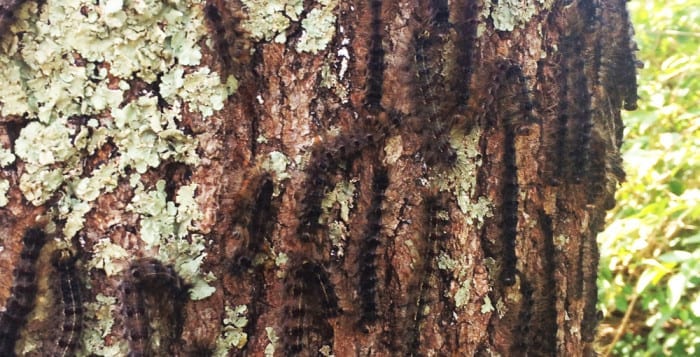By Ellen Barcel
Recently I received a photo of a Long Island oak tree covered in gypsy moth caterpillars from a reader who noted that chopped leaves were all over her yard and the caterpillar’s droppings covered her driveway. Moths seemed to be everywhere. What was going on?
Well, periodically, when the conditions are right, infestations of certain pests seem to explode. In this case, her offenders were gypsy moth caterpillars. The adult female gypsy moth is whitish in color with a few small brown spots. The male is slightly smaller and is tan with darker brown coloring.
It’s not the moths themselves but the larvae which do a number on the leaves of so many hardwood trees. The moth is indigenous to Europe, but was introduced to the United States when someone thought they could be used to cross with silkworms to develop a silk industry here. That never worked out, but the larvae have attacked trees, particularly in the Northeast, where they have continued to spread south and west.
The gypsy moth was soon recognized as a pest, defoliating trees. Accounts from the late 1800s talk about caterpillars covering roofs and sidewalks.
The female moth lays its eggs which overwinter. In spring, the eggs hatch, and the larvae emerge and feed voraciously on leaves. Usually in early summer the larvae turn into pupa, a stage which lasts two or more weeks. Then the skin splits open and the moth emerges to start the cycle over again. This time line varies as I already saw a female gypsy moth.
Like butterflies, the moths can’t eat, but can consume moisture. So it’s not the moth that’s the problem — it’s the caterpillar. Moths tend to be active at night, while butterflies are active during the day. The moths don’t have a long lifespan, just about a week, just long enough to mate and lay eggs.
The U.S. Department of Agriculture notes that the caterpillars emerge from the eggs at about the same time that trees begin to grow in early spring. While the larvae feed on many different species of trees, on Long Island they can be found on oak, pine, catalpa, dogwood, American holly, mountain laurel and arborvitae.
Encouraging birds to nest in your garden will help somewhat, as they will eat the caterpillars. But in a major infestation, they just can’t keep up.
The Dept. of Agriculture notes that most healthy trees can recover from infestations and grow a new set of leaves, but that trees already weakened by disease are more likely to die as a result of severe infestation. Repeated infestations also weaken trees, making them more prone to disease. Weather can affect outbreaks. Severely cold winters can kill the eggs, for example.
By now, the worst is over. But, as a gardener, what can you do if you are concerned about a future infestation? Because the life cycle of gypsy moths is year-round, control must be also. Don’t assume that now that the caterpillars are gone, the problem is over. They’ll be back again next year. The Dept. of Agriculture recommends the following:
Now:
* Diversify the type of trees you have in your garden
* Destroy egg masses if you see them — they look like a tan colored mass on wood (even firewood and wood furniture), and under leaves.
* Feed, water and fertilize trees as needed to keep them healthy. That way they can recover more easily in a major infestation.
Next spring:
*Use a band of burlap around the base of your trees, particularly oaks, in spring. Lift it up periodically to see how bad the infestation is. Then remove and destroy caterpillars manually if you can.
* Use double sided tape around trees to prevent the caterpillars from climbing up the trunk to the leaves.
* If you’ve had a particularly bad infestation this year, consider having a professional apply a pesticide next spring. This is a last resort, only to be used if your trees were badly damaged this year.
Ellen Barcel is a freelance writer and master gardener. To reach Cornell Cooperative Extension and its Master Gardener program, call 631-727-7850.





